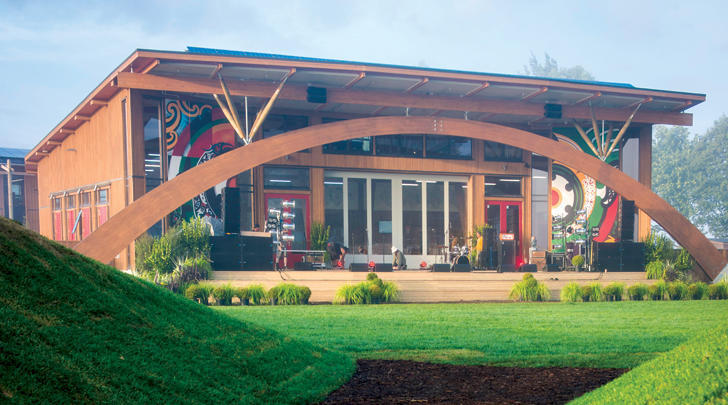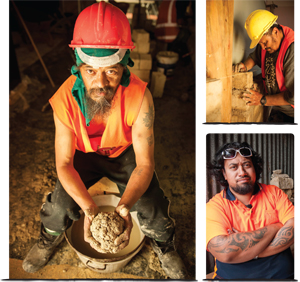People
Tūhoe rising
Sam Judd

Bloodshed, defiance,’ terror’ raids – the 'children of the mist' have endured hardship, poverty and controversy unmatched in New Zealand’s history. Yet today, in the tiny town of Taneatua in the eastern Bay of Plenty, the construction of a remarkable building has sent a message to the world about the renaissance of this fiercely independent tribe. Ngai Tūhoe’s new headquarters – known as Te Uru Taumatua – has set out a vision for Tūhoe destiny that holds sustainability and guardianship of the environment as core values.
A grim history
The history of the Tūhoe people isn’t well known in New Zealand. Hailing from the lands in and around what is now Te Urewera National Park, Ngai Tūhoe never signed the Treaty of Waitangi and over the years have endured severe hardship and injustice.
During the New Zealand land wars Crown forces used brutal tactics against Tūhoe, destroying homes, food stores and crops and killing or driving off stock. By the time a peace agreement was signed in 1871, one in eight Tūhoe people had perished – mainly due to starvation and illness.
Over the next 25 years the Crown sent surveyors accompanied by soldiers to the Tūhoe territories, aggressively seeking land for development. In 1896, in response to protests and confrontations over the surveys, then Premier Richard Seddon enacted The Urewera District Native Reserve Act 1896, or Te Ture Motuhake o Tūhoe ('the independent law of Tūhoe'). This law granted to Tūhoe what they had always maintained: their right to independently manage their territory, and applied to the remaining 265,000 hectares of Tūhoe land.
However, in the following years this arrangement was repeatedly breached as the Crown aggressively purchased shares in land blocks and imposed a land consolidation scheme that included tactics such as creating improper debt and forcing Tūhoe to pay for roads that were never built by relinquishing more land. The end of this scheme left the Tūhoe people with 42,500 hectares – or about 16 per cent of the land that the crown had agreed to let them self-manage.
Much of the land that remained was unfit for farming and became Te Urewera National Park in 1954. Today, more than 80 per cent of Nga Tamariki o te Kohu (the children of the mist), as Tūhoe are known, live outside their traditional lands – and those who remain are some of the most impoverished in New Zealand. In a recent index of poverty levels by Otago University, the area ranked as the most deprived in the country. A bitter resentment of the Crown remained in the region, which came to a head in 2007 with a Police operation targeting what they believed at the time were terrorist training camps.
The Tūhoe renaissance
Despite their setbacks, Tūhoe’s leaders have stuck at negotiations with the Crown and in 2013, with issues over the so-called ‘terror training camps’ resolved, they achieved what once seemed impossible: a settlement that laid to rest the grievances of the past.
Under the agreement the Crown apologised for former wrongdoings and Tūhoe gained governance (rather than ownership) of Te Urewera National Park, plus $170 million in redress payments.
The historic agreement proved a springboard for the tribe, which decided it needed once again to have a central hub – a meeting place for its scattered people.
This would be no ordinary office though; the tribe’s leaders set out to create a truly sustainable building – something that would showcase Tūhoe values of living at one with nature and nurturing their environment.
“People come and go,” says Kirsti Luke, Tūhoe’s chief executive. “But if your natural resources are depleted, people have nothing. That’s the order of things.”
This was to be more than just a few solar panels, recycling bins and a green star rating. In collaboration with the innovative Kiwi building company Arrow International and sustainable architecture gurus Jasmax, Tūhoe set out to build the most advanced eco-friendly building in New Zealand, and one of the most sustainable modern buildings on the planet. In March this year Te Uru Taumatua was revealed to the world.
The Living Building challenge
Te Uru Taumatua was built according to the Living Building standards created by visionary architect Jason McLennan. His philosophy is that it’s no longer enough to make buildings “less bad” by minimising their impact. Instead, his Living Building standard requires structures to actually give back to the community and environment.
“We’re not interested in buildings that are less likely to give you cancer – we want buildings that can’t,” says McLennan. “Not buildings that require less toxic fossil fuel, but none. And we have to create solutions that are good for all of humanity, not just the wealthy.”
To qualify as a Living Building a project must achieve what is called 'triple net zero performance' in carbon emissions, energy and water use. This means the building must produce at least as much energy as it consumes, use only rainwater falling on the site and be entirely carbon neutral. And even though it’s now complete, the Tūhoe building must be audited for a year before it becomes the first certified Living Building in the Southern Hemisphere.
Made from the land
It’s not just being off the grid or the onsite sewage treatment that makes Te Uru Taumatua unique. Even the building’s bricks, mortar and timber were harvested from the land that defines the Tūhoe people, and are as much a part of the story as the people who put them together.
To meet the Living Building challenge everything had to pass the test of being free of harmful chemicals – and anything from out of town had to be weighed up against that which was sourced locally. Most of the materials used came from a radius of within 100km of the site and 95 per cent of the timber lived and fell on Tūhoe land.
Native wood was used for external cladding, interior lining and custom-made cabinetry, and much of this was sourced from ‘storm timber’ – naturally fallen logs found on the forest floor. When exotic timber was used – in the exposed structural beams and rafters, as well as floor and roof framing for instance – this came from Tūhoe-owned FSC-certified pine plantations.
Meanwhile, the internal walls were built from some 5000 earth bricks made of clay from different parts of Tuhoe country. Using clay was a way to use a sustainable building material that regulates moisture and temperature inside, plus gave locals a chance to get their hands dirty and be a part of the project.
Uniting the community

In all, 70 per cent of the labour on the site was carried out by Tūhoe people – giving them valuable high-level industry experience on a major project, and an excellent reason to reconnect with their homeland.
During construction 10 locals were trained in the art of earth-brick making. They then trained, motivated and supervised more than 150 volunteers who spent three weeks making the bricks – a truly collaborative project that passed on key knowledge about how to build healthy homes on a budget.
Each day people flocked from as far as Australia, Tauranga and Ruatahuna to lend a hand, side by side with people from local businesses, schools and hapu, while top carvers worked on artworks.
This dynamic was vital for Luke: “The labour that goes into the production of the materials was all carefully constructed to have a very local flavour and in so doing, create personal relationships between all of those people of Tūhoe and the Bay of Plenty and their whare.”
The result is something that functions not just as a headquarters for the tribe’s leaders, but also as a community hub with a library, café and space that all Tūhoe can be proud to call their own.
A new future for Tūhoe
Tūhoe have always had a strong sense of identity – and indeed have the greatest percentage of Te Reo Maori speakers in the country, with 40 per cent of those registered with the central Tūhoe authority being fluent. So the tribe’s leaders are proud to have created a permanent focal point for the tribe and its values.
“We are finally able to bring to life something real to offer the Tūhoe communities of the future, a way of living that respects the land, bringing people closer to the constraints that nature intended,” says Luke.
Two more projects are now in the pipeline, including a visitor’s centre at Waikaremoana, and these will be built with the same combination of traditional materials and good old-fashioned community working bees with state-of-the-art technology like photovoltaic systems.
Yet for all the fancy systems and ideas these projects use, for Luke, forging into the future means looking back to the past: “It’s how things used to be. When it was hot, we’d open a window. When it was cold, we’d throw on a sweater. Embracing simple concepts like this are not only good for the environment that surrounds us, it’s good for us too.
“It reminds us about what’s important; about people and our place within the bigger scheme of things.”
What makes Te Uru Taumatua so green?
- 352 solar panels, generating 12,500 kWh per year
- 73kW emergency battery system
- Two 25,000 litre rainwater storage tanks, with UV filters
- A purpose-designed system of septic tanks, ponds, and wetlands that can turn 5,000 litres of toilet and kitchen waste into drinkable water each day
- An edible garden plus numerous fruit trees, native trees, plants and ferns
- During construction most waste was diverted from landfill including 95 per cent of metals and paper, all soil and 90 per cent of rigid foam and insulation
- Off-cuts and usable timber framing were donated to local schools
